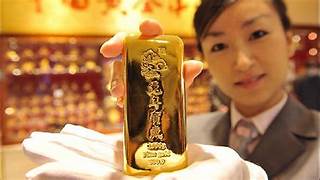Digital Zeitgeist – China’s Sparkling Obsession: A Soaring Affinity for Jewellery and Precious Metals Amidst Economic Uncertainties
Q1/Q2 2023 – Report From China
In the shimmering skyline of Shanghai, one might imagine the bustling streets alive with consumerism – tech gadgets, trendy fashion, and luxury automobiles. However, the actual retail pursuit may surprise many: gold, gems, and jewellery. As China pivots its economic model towards domestic spending, following years of rigorous COVID restrictions, its citizens, it seems, are hedging their bets. And their choice of safe haven? The time-tested allure of precious metals and gemstones.
Violet Zhu, a Shanghai entrepreneur, is emblematic of this trend. Eschewing the traditional stock markets and mutual funds – often regarded as standard wealth growth vehicles – she has instead veered towards buying precious stones. Her focus? Oddly-shaped, high-grade rubies. Zhu’s rationale is simple: the potential of these gems to appreciate over time. She is not alone in this quest, as evidenced by the recent surge in jewellery and precious metals consumption in China, up by a staggering 37.4% in March, year-on-year.
According to recent data, China’s retail sales in Q1 burgeoned by a whopping 10.6%, eclipsing even the most optimistic forecasts of 7.4%. This makes for impressive headlines, but beneath the surface lurk deeper concerns. While the economy has grown, the growing fondness for gold and jewellery signals an underlying anxiety. Marco Sun, the chief financial analyst at MUFG Bank (China), points out that despite the upswing in high-end consumption, the story of a fragile recovery persists.
The roots of this cautionary trend can be traced back to significant global financial upheavals. When institutions of the stature of Silicon Valley Bank falter and when banking giants like Credit Suisse are forced into sales, ripples of insecurity permeate the global financial milieu. Ben Cavender of China Market Research Group posits that the Chinese consumer’s gravitation towards precious metals is motivated by the twin desires of seeking refuge and hedging against inflation. In essence, there’s a prevailing sense that the era of low inflation in China might be drawing to a close.
This sentiment is further underscored by the savings behaviour of Chinese households. In 2022, savings grew by a record 17.8 trillion yuan, and this was no anomaly. The January-March period in 2023 saw a rise of 9.9 trillion yuan, mirroring the growth of 2021. As Pang Xichun of Nanjing RiskHunt Investment Management Co. elucidates, this pivot towards jewellery and precious metals is driven by a trifecta of economic fundamentals, risk aversion, and the rejuvenation of domestic consumption.
Conclusion: A Devil’s Advocate Perspective
However, playing devil’s advocate, could this penchant for precious metals and gems also be perceived as a reflection of the Chinese consumer coming of age? Historically, in many cultures, gold and precious stones have not merely been viewed as safety nets but also as symbols of prosperity and status. Perhaps the surge in gold and jewellery buying is not just a hedging strategy, but also an affirmation of newfound wealth and an aspiration for tangible luxury. While economic fundamentals and risk aversion surely play a role, it might also be the Chinese consumer’s way of asserting their place on the global stage, a declaration that they have arrived. In the shifting sands of geopolitics and global finance, understanding these nuances might just be the key to deciphering the Middle Kingdom’s next move.
Disclaimer: The views and opinions expressed in this article are those of the author and do not necessarily reflect the official policy or position of GPM-Invest or any other organisations mentioned. The information provided is based on contemporary sourced digital content and does not constitute financial or investment advice. Readers are encouraged to conduct further research and analysis before making any investment decisions.

